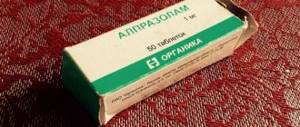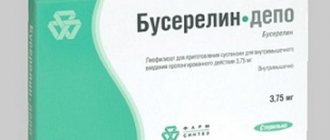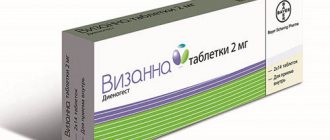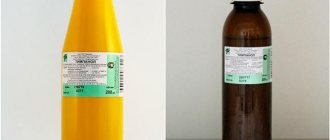Dexamethasone is a drug belonging to the group of glucocorticosteroids and is a hormonal agent.
It is widely used in medicine in various fields. It is produced in the form of a solution, which is used for injection intravenously, intramuscularly and for instillation into the conjunctiva of the eyes.
On this page you will find all the information about Dexamethasone: complete instructions for use for this drug, average prices in pharmacies, complete and incomplete analogues of the drug, as well as reviews of people who have already used Dexamethasone injections. Would you like to leave your opinion? Please write in the comments.
Pharmacological effect
Dexamethasone is a homologue of hydrocortisone, a hormone produced by the adrenal cortex.
It interacts with glucocorticoid receptors, regulates sodium and potassium metabolism, water balance and glucose homeostasis. Stimulates the production of enzyme proteins in the liver, affects the synthesis of mediators of inflammation and allergies, and inhibits their formation. As a result, the product gives an anti-inflammatory, anti-allergic, immunosuppressive, and anti-shock effect.
When administered intramuscularly, the therapeutic effect is observed after 8 hours, after intravenous infusion, faster. The effect lasts from 3 days to 3 weeks when administered locally, 17 - 28 days after administration intravenously. Dexamethasone has a strong anti-inflammatory and antiallergic effect. It is 35 times more effective than cortisone.
Price of Dexamethasone in ampoules
The drug is available in the format of tablets, injection ampoules and eye drops. Solutions for injections have a dosage of 4 mg of active substance per 1 ml, presented in a package of 10 pieces. Each test tube is made of transparent glass. Another form of release of Dexamethasone ampoules contains five injection units inside a contoured blister pack made of polymer film, two pieces in a cardboard box.
The instructions for use of the drug urge caution in patients with arterial hypertension, heart failure, glaucoma, epilepsy, myasthenia gravis and thromboembolism. There are other restrictions:
- the effect of the drug may increase liver cirrhosis and hypothyroidism;
- treatment can mask infectious signs, aggravate systemic fungal diseases, latent amebiasis, pulmonary tuberculosis;
- during therapy, vaccination with live viruses is contraindicated due to the lack of the expected production of antibodies and preventive action;
- cannot be used eight weeks before and two weeks after vaccinations;
- Not recommended for use in treatment after surgery or bone fracture.
- the medicine slows down the healing and formation of callus;
- The drug is stored for two years at temperatures up to 25 degrees, it cannot be frozen;
- specific conditions for dispensing from a pharmacy - by prescription.
Why is Dexamethasone prescribed?
- For gastrointestinal diseases: Crohn's disease and ulcerative colitis.
- For systemic connective tissue diseases: acute rheumatic carditis; systemic wolf lichen ruber.
- For endocrine disorders: insufficiency of the adrenal cortex and their congenital hyperplasia; subacute form of inflammation of the thyroid gland.
- For rheumatic diseases: bursitis; rheumatoid arthritis; psoriatic and gouty arthritis; osteoarthritis; synovitis; nonspecific tenosynovitis; ankylosing spondylitis; epicondylitis accompanying osteoarthritis.
- For allergic diseases: contact and atopic dermatitis; status asthmaticus; serum sickness; allergies to food and certain medications; angioedema; allergic rhinitis (seasonal or chronic); bronchial asthma; urticaria associated with blood transfusion.
- For skin diseases: severe erythema multiforme; pemphigus; exfoliative, bullous herpetiform and severe seborrheic dermatitis; fungoid mycosis; psoriasis.
- For eye diseases: optic neuritis; symptomatic ophthalmia; allergic corneal ulcers; keratitis; iridocyclitis; iritis; uveitis (anterior and posterior); allergic forms of conjunctivitis.
- For respiratory diseases: Loeffler's syndrome; tuberculosis; sarcoidosis 2nd-3rd degree; aspiration pneumonia; berylliosis.
- For kidney diseases: impaired renal function associated with systemic wolf's lichen erythematosus; idiopathic nephrotic syndrome.
- For malignant diseases: leukemia (acute) in children; lymphoma and leukemia in adults.
- In case of shock: shock that cannot be treated with classical methods; anaphylactic shock; shock in patients suffering from insufficiency of the adrenal cortex.
- For hematological diseases: idiopathic thrombocytopenic purpura; erythroblastopenia; congenital hypoplastic anemia; autoimmune hemolytic anemia; thrombocytopenia secondary.
- For other indications: myocardial trichinosis; trichinosis with neurological signs; tuberculous meningitis.
What does Dexamethasone help with?
Indications for use include diseases requiring the administration of fast-acting corticosteroids, as well as cases when oral administration of the drug is impossible:
- local application (in the area of pathological formation): keloids, discoid lupus erythematosus, granuloma annulare;
- cerebral edema (with a brain tumor, traumatic brain injury, neurosurgical intervention, cerebral hemorrhage, encephalitis, meningitis, radiation injury);
- severe bronchospasm (exacerbation of bronchial asthma, chronic obstructive bronchitis);
- acute severe dermatoses;
- rheumatic diseases;
- status asthmaticus;
- systemic connective tissue diseases;
- shock (burn, traumatic, surgical, toxic) - if vasoconstrictors, plasma replacement drugs and other symptomatic therapy are ineffective;
- severe allergic reactions, anaphylactic shock;
- endocrine diseases: acute adrenal insufficiency, primary or secondary adrenal insufficiency, congenital adrenal hyperplasia, subacute thyroiditis;
- blood diseases: acute hemolytic anemia, agranulocytosis, idiopathic thrombocytopenic purpura in adults;
- severe infectious diseases (in combination with antibiotics);
- malignant diseases: palliative treatment of leukemia and lymphoma in adult patients; acute leukemia in children; hypercalcemia in patients suffering from malignant tumors when oral treatment is not possible.
Why is Dexamethasone prescribed in ophthalmic practice:
- allergic conjunctivitis;
- keratoconjunctivitis without damage to the epithelium;
- clerite;
- blepharitis;
- keratitis;
- inflammatory process after eye injuries and surgical interventions;
- iridocyclitis;
- immunosuppressive treatment after corneal transplantation;
- iritis;
- sympathetic ophthalmia;
- blepharoconjunctivitis;
- episcleritis.
Contraindications
The use of Dexamethasone is contraindicated in patients with hypersensitivity to the components of the drug.
Dexamethasone is prescribed with caution for:
- diseases of the cardiovascular system;
- endocrine diseases;
- peptic ulcer, gastritis, esophagitis, newly created intestinal anastomosis, diverticulitis;
- parasitic and infectious diseases of various nature;
- immunodeficiency states;
- severe liver or kidney failure, nephrourolithiasis, hypoalbuminemia;
- glaucoma, poliomyelitis, acute psychosis, systemic osteoporosis.
The use of Dexamethasone by pregnant and lactating women, as well as children, should only be prescribed by a doctor after taking into account all possible risks.
Conditions of release, storage and sale
Release form: Solution for injection 4 mg/ml 1 ml. 1 ml in a clear glass ampoule with a break ring or a break point. Self-adhesive labels are placed on the ampoules.
10 ampoules along with “Dexamethasone in ampoules instructions for use” are placed in a pack with a corrugated cardboard partition.
Storage conditions: Store at a temperature not exceeding 25 ºС. Keep ampoules in outer packaging to protect from light. Keep out of the reach of children! Shelf life: 2 years. Do not use the drug after the expiration date indicated on the package. Conditions for dispensing from pharmacies - By prescription.
, Ukraine, 04080, Kyiv, st. Frunze, 63. The owner of the registration certificate is PJSC Farmak, Ukraine.
Use during pregnancy and lactation
Dexamethasone in the form of tablets and drops is prohibited for use during pregnancy and lactation. If during breastfeeding there is a need for treatment with Dexamethasone, the child is transferred to artificial formula.
Dexamethasone injections during pregnancy are given only for health reasons. For example, the drug may be prescribed when the immune system begins to perceive the embryo as a foreign body. Dexamethasone suppresses immune activity, which eliminates the threat of miscarriage and maintains pregnancy.
Directions for use and doses
The drug in higher doses can be administered only until the patient’s position returns to normal (usually 48-72 hours are required).
If an adult is in serious condition, then the drug is injected into a vein very slowly or 3-4 (per day) droppers are placed with intravenous administration of Dexamethasone in a volume of 4-20 mg. It is permissible to administer no more than 80 mg of solution at a time. To support the patient, 0.2-9 mg is injected throughout the day. And after 3-4 days they start dispensing tablets.
Instructions for use
The instructions for use indicate that the dosage regimen is individual and depends on the indications, the patient’s condition and his response to therapy.
- The drug is administered intravenously in a slow stream or drip (for acute and emergency conditions); i/m; local (into the pathological formation) administration is also possible. To prepare a solution for intravenous drip infusion, you should use an isotonic sodium chloride solution or a 5% dextrose solution.
- In the acute period for various diseases and at the beginning of therapy, Dexamethasone is used in higher doses. During the day, you can administer from 4 to 20 mg of Dexamethasone 3-4 times.
Doses of the drug for children (i.m.):
- The dose of the drug during replacement therapy (for adrenal insufficiency) is 0.0233 mg/kg body weight or 0.67 mg/m2 body surface area, divided into 3 doses, every 3rd day or 0.00776 – 0.01165 mg/kg body weight or 0.233 – 0.335 mg/m2 body surface area daily. For other indications, the recommended dose is from 0.02776 to 0.16665 mg/kg body weight or 0.833 to 5 mg/m2 body surface area every 12-24 hours.
- When the effect is achieved, the dose is reduced to maintenance or until treatment is stopped. The duration of parenteral use is usually 3-4 days, then they switch to maintenance therapy with dexamethasone tablets.
Long-term use of high doses of the drug requires a gradual dose reduction in order to prevent the development of acute adrenal insufficiency.
pharmachologic effect
The instructions for use of the drug list the indications for use. The use of dexamethasone varies depending on the pathology. Deksametazon, when administered orally, acts at the cellular level, causing cytoplasmic receptors to react.
Since transmembrane receptors are present in all organs and tissues, the synthetic glucocorticosteroid acts systemically.
Side effects of Dexamethasone
The instructions for use of Desoximetasone contain information that the drug effectively eliminates:
- inflammatory processes in organs and tissues, including the liver, kidneys, eyes, skin,
- acts as an immunosuppressant,
- suppresses allergic reactions,
- brings the patient out of shock,
- promotes the elimination of toxins in case of poisoning,
- removes excess fluid from the body.
In general, dexamethasone and its analogues change the body's metabolism in all systems, which is why it is so important to follow the instructions. When taken orally or injected, the medicine is quickly and completely absorbed by the body.
Note! The instructions for use warn not only about the strong effects of dexamethasone on the body, but also about the prolongation effect. Wrong dosage will cause side effects.
The half-life of the active substance is from one and a half to two and a half days. The drug Dexamethasole is processed in the liver and excreted from the body through the urinary system.
Lipid metabolism
The use of dexamethasone (or its analogues) stimulates the formation of triglycerides and fatty acids. In this case, triglycerol concentrates the deposition of subcutaneous fat in the upper torso. The patient takes on the characteristic appearance of a person “who is on hormones.” The patient's shoulder girdle, face and abdomen enlarge. Arms and legs, as a rule, gain weight slightly, but are susceptible to swelling.
Note! Using the drug without clear instructions from the attending physician may increase the level of bad cholesterol in the blood. This, in turn, threatens vascular complications in the legs, coronary heart disease, and the development of hypertension.
Article on the topic: Allergies to synthetics, fabric, clothing, viscose
Carbohydrate metabolism
The use of Dexamethasone enhances the absorption of carbohydrates from the intestines. At the same time, it stimulates the flow of glucose reserves from the liver into the blood, which increases the level of glucose in the blood, reaching hyperglycemia.
Dexamethasone injection intramuscularly
Protein metabolism
According to the instructions, in terms of the effect on protein metabolism in the body, the use of dexamethasone shifts the globulin-albumin balance towards the predominance of albumin in the blood. Increases the intensity of protein breakdown in muscle tissue, while simultaneously reducing the formation of complex protein molecules (globulins). Stimulates the synthesis of albumin in the liver and kidneys.
Dexamethasone release form
Water-salt balance
Taking Dexamethasone, even if the instructions are followed, can contribute to the retention of sodium and water ions in the body. The glucocorticosteroid leaches potassium. Weakens bones by interfering with the absorption of calcium from food. With long-term use of dexamethasone, patients have an edematous appearance and pronounced tissue pastiness.
Dexamethasone solution
Thus, stimulation of carbohydrate absorption and changes in water-salt balance when taking dexomethasone lead to the accumulation of adipose tissue (Cushing's syndrome) and the development of osteoporosis. These two effects according to the instructions are the most common contraindication to long-term therapy.
Note! The effect of dexamethasone on metabolism is dose-dependent (method of administration, dosage, duration of treatment). When following the instructions for taking the drug, it is expressed to a minimal extent.
The instructions warn that using the drug in children may slow their growth. This is explained by the ability of glucocorticosteroids to enhance decay processes in the tissues of the body. The following may be affected: bone, connective, muscle, adipose tissue, as well as the dermis.
How to use Dexamethasone
The anti-inflammatory effect is explained by the ability of dexamethasone to suspend the production of inflammatory mediators. Initiates the production of more lipokartin. Taking the drug prevents the destruction of lysosomes, which is especially important for inflammatory joint pathologies. In the treatment of arthritis, the instructions recommend the use of lotions and compresses with dexamethasone solution. The local form of application effectively relieves inflammation, constricts blood vessels in the area of action of the solution or ointment.
Note! The success of anti-inflammatory therapy with dexamethasone depends on complex treatment.
In parallel, the patient is prescribed a course of antimicrobial therapy (for example, Ciprofloxacin), antibiotics (for example, Tobramycin, for pneumonia Ciprofloxacin hydrochloride, in gynecology Gentamicin). For women with inflammatory diseases Stizon.
The immunosuppressive effect is explained by the ability of dexamethasone to suppress the activity of lymphocytes and macrophages.
The antiallergic effect consists of the complex action of the drug on the body. Reduces the manifestations of allergies by inhibiting the production of histamines, the anti-inflammatory effect that Dexamethasoni has on the blood composition.
Dexamethasone during breastfeeding
The instructions warn that in high doses, dexamethasone has an exciting effect on the brain, increasing synapse activity. This may manifest itself as an epileptic attack or convulsive syndrome. You need to monitor your condition and blood counts.
Side effects
During treatment with Dexamethasone in the form of injections, patients may experience the development of the following side effects:
- From the skin and mucous membranes: delayed wound healing, petechiae, ecchymoses, thinning of the skin, hyper- or hypopigmentation, steroid acne, stretch marks, tendency to develop pyoderma and candidiasis;
- From the senses: posterior subcapsular cataract, increased intraocular pressure with possible damage to the optic nerve, a tendency to develop secondary bacterial, fungal or viral eye infections, trophic changes in the cornea, exophthalmos, sudden loss of vision (with parenteral administration in the head, neck, nasal shells, scalp, possible deposition of drug crystals in the vessels of the eye);
- From the metabolic side: increased excretion of calcium, hypocalcemia, increased body weight, negative nitrogen balance (increased breakdown of proteins), increased sweating. Caused by mineralocorticoid activity - fluid and sodium retention (peripheral edema), hypsarnatremia, hypokalemia syndrome (hypokalemia, arrhythmia, myalgia or muscle spasm, unusual weakness and fatigue);
- From the endocrine system: decreased glucose tolerance, steroid diabetes mellitus or manifestation of latent diabetes mellitus, suppression of adrenal function, Itsenko-Cushing syndrome (moon-shaped face, pituitary-type obesity, hirsutism, increased blood pressure, dysmenorrhea, amenorrhea, muscle weakness, stretch marks) , delayed sexual development in children;
- From the cardiovascular system: arrhythmias, bradycardia (up to cardiac arrest); development (in predisposed patients) or increased severity of heart failure, changes in the electrocardiogram characteristic of hypokalemia, increased blood pressure, hypercoagulation, thrombosis. In patients with acute and subacute myocardial infarction - the spread of necrosis, slowing down the formation of scar tissue, which can lead to rupture of the heart muscle;
- From the musculoskeletal system: slowing of growth and ossification processes in children (premature closure of the epiphyseal growth plates), osteoporosis (very rarely - pathological bone fractures, aseptic necrosis of the head of the humerus and femur), rupture of muscle tendons, steroid myopathy, decreased muscle mass (atrophy). Dexamethasone instructions for use;
- From the nervous system: delirium, disorientation, euphoria, hallucinations, manic-depressive psychosis, depression, paranoia, increased intracranial pressure, nervousness or anxiety, insomnia, dizziness, vertigo, pseudotumor of the cerebellum, headache, convulsions.
- From the digestive system: nausea, vomiting, pancreatitis, steroid ulcer of the stomach and duodenum, erosive esophagitis, gastrointestinal bleeding and perforation of the wall of the gastrointestinal tract, increased or decreased appetite, indigestion, flatulence, hiccups. In rare cases, increased activity of liver transaminases and alkaline phosphatase;
Interaction with other drugs
Drug interactions are possible in combination with other drugs, but it is recommended to carry out therapy separately from other drugs.
- Combination with diuretics increases potassium excretion and increases the risk of developing heart failure.
- Concomitant use with sodium-containing drugs causes peripheral edema and arterial hypertension.
- from taking cardiac glycosides worsens
- Combination with NSAIDs increases the risk of ulcerative lesions of the gastrointestinal tract.
The decision about interactions with other drugs should only be made by a doctor.
special instructions
- For patients with liver abnormalities, Dexamethasone is prescribed with particular caution.
- In order to reduce the risk of side effects, the patient should follow a diet high in potassium. Food should be rich in proteins, carbohydrate and salt intake should be slightly reduced.
- During treatment with Dexamethasone, patients should constantly monitor blood pressure, the state of the visual organs, water and electrolyte balance and the clinical picture of the blood.
- Treatment with the drug should not be stopped abruptly, as in this case the risk of developing withdrawal syndrome increases, a condition that is accompanied by an increase in the primary symptoms of the disease and suppression of adrenal function.
- Patients with diabetes mellitus should constantly monitor blood glucose levels and, if necessary, adjust the daily dose of hypoglycemic drugs.
- When using the drug in pediatric practice, you should carefully monitor the dynamics of the child's growth, since long-term use of the drug in large doses can lead to inhibition of the patient's growth.
Dexamethasone injections: indications for use
Dexamethasone is a medicine that can cause serious complications if not treated correctly. Before using the drug, it is necessary to study the properties, application features and possible side effects.
Pharmacological form and main properties
Dexamethasone is an injection solution that is widely used in pharmacology. Active ingredient: dexamethasone phosphate, auxiliary ingredients: glycerin, disodium edetate, sodium hydrogen phosphate dihydrate, water. The drug is capable of providing antishock, antiallergic and antitoxic effects. It is produced in ampoules of 5 mg. The cost varies from 25 to 500 rubles.
Main properties of the drug:
- Acceleration of protein production
. Dexamethasone promotes protein production in muscle tissue and increases albumin production in the liver and kidneys. - Acceleration of lipid (fat) metabolism
. The drug affects fat deposits, redistributing cholesterol cells from the subcutaneous area of the extremities to the waist, face and shoulder girdle. - Acceleration of carbohydrate metabolism
. Under the influence of the drug, glucose enters the blood faster from the liver. - Anti-inflammatory effect
. Dexamethasone suppresses acid production in tissues and stabilizes cell membranes, increasing cell resistance to destructive effects. Prevents cell death. - Antiallergic effect
. The drug inhibits the development of the body's allergic reaction and reduces swelling of the mucous membranes.
Dexamethasone can be combined with antibiotics to enhance the drug effect.
Dexamezone can replace taking other antiallergic drugs.
Approximate dosage: 0.5 mg corresponds to 3.5 mg of Prednisolone, 17.5 mg of Cortisone or 15 mg of Hydrocortisone.
Indications for use
For some diseases, taking medication in tablets is difficult or even impossible. The patient can only tolerate Dexamethasone injections, for which intramuscular injections are prescribed. Indications for this method of drug administration will be:
- Rheumatic diseases
. Dexamethasone alleviates symptoms of bursitis, arthritis, and connective tissue inflammation. - Endocrine diseases
. These include adrenal hyperplasia and thyroiditis. - Malignant tumors
. In the treatment of oncology, Dexamethasone is used as a palliative agent.
To obtain a therapeutic effect as quickly as possible, the drug is administered intravenously. This is necessary in case:
- transient development of shock (traumatic, burn, toxic);
- cerebral edema due to intracranial hemorrhage or traumatic brain injury;
- severe allergies;
- acute renal failure;
- severe pain in the back, neck and chest area: possible
- acute leukemia;
- acute forms of lung diseases;
- severe infectious diseases.
It is also possible to use the medicinal solution locally: it is applied to keloid scars and pathological rashes on the skin.
Contraindications for taking Dexamethasone
An absolute contraindication is individual hypersensitivity to the drug. Injections are also prescribed with caution in pathological conditions:
- Gastrointestinal diseases
. During exacerbation of gastritis and peptic ulcers, the risk of perforation (tissue rupture) increases. Dexamethasone can speed up this process and cause internal bleeding. - Infectious and parasitic diseases
. During the development of a disease of a bactericidal or viral nature, any drugs can only be an addition to the main treatment. - Vaccination period
. You must wait 2 to 8 weeks before and after vaccination. Dexamethasone cannot be taken if you have an immunodeficiency state (AIDS or HIV). - Diseases of the cardiovascular system
. A previous heart attack is the main contraindication - the patient may experience an increase in the area of necrosis of cardiac tissue. This slows down the scarring process and leads to rupture of the heart muscle. - Endocrine diseases
. In diabetes mellitus, the drug will provoke the development of obesity.
It is undesirable to take the drug in case of mental pathologies, in particular in acute psychosis. Dexamethasone may increase symptoms and cause hallucinations. Also, the effect of Dexamethasone can increase the manifestation of depression and anxiety.
Instructions for use and dosage
The dosage is selected individually depending on the severity of the disease. When administered through a drip, Dexamethasone is administered slowly, drip or stream. Daily dose for adults: from 4 to 20 mg, number of procedures – 3-4.
The drug can be administered intravenously for 3-4 days, after which the patient is transferred to the oral form (taking the medicine in tablets). During the acute period, doses may be higher and reach 100-150 mg of the drug per day.
After achieving a therapeutic effect, the dose is reduced to a maintenance dose or treatment is stopped.
The drug does not cause water and sodium retention in the body, and no special drinking regimen is required during treatment. But after the introduction of the dropper, the patient may feel a headache, slight dizziness and nausea. In order for the unpleasant symptoms to go away, it is recommended not to get up immediately after the procedure, but to wait 10-15 minutes.
If the drug must be injected, the needle is inserted not under the skin, but into the muscle tissue. It is of great importance how to administer Dexamethasone intramuscularly: quickly or slowly.
If Dexamethasone suddenly enters the tissue at the puncture site, a hematoma may appear. To avoid this, the medicine must be administered gradually, monitoring the patient's condition.
An allergic reaction to the action of the medicine may appear within 5-10 minutes, so after the injection the patient must be observed for 10-15 minutes.
Side effects
Most patients do not experience side effects from taking Dexamethasone. But some patients may experience reactions from different organ systems:
- Endocrine system: short-term increase in blood pressure, swelling, muscle weakness, increased symptoms of diabetes.
- Digestive system: gastritis, gastric ulcer, bloating, indigestion, pancreatitis, loss of appetite.
- Cardiovascular system: heart rhythm disturbances, risk of thrombosis, feeling of heaviness in the heart area.
- Nervous system: dizziness, headaches, convulsions, depression, hallucinations, nervousness, anxiety, insomnia.
- Sense organs: short-term loss of vision, increased intraocular pressure, increased risk of developing a viral eye infection.
- Metabolism: increased sweating, accelerated excretion of calcium from the body, increased body weight, weakness, fatigue.
- Musculoskeletal system: slowing down the ossification process in children, decreased muscle elasticity, decreased muscle mass, osteochondrosis.
- Skin and mucous membranes: slow healing of wounds, pigmentation on the skin, the appearance of rashes and acne, itching.
During administration of the drug, local reactions may be observed: tingling, numbness, burning. After healing, a scar may form at the injection site. Occasionally, necrosis of the surrounding tissue occurs. Compliance with the rules for administering the drug helps to avoid this: disinfection of the puncture site and slow administration of the drug.
Using Dexamethasone during the development of an infection leads to an exacerbation of symptoms and slows down treatment!
When the drug is administered intravenously, patients with hypersensitivity may suffer from flushing of the face, limb cramps and arrhythmia.
Use during pregnancy
The drug is not recommended to be taken during pregnancy, especially during the first trimester. Dexamethasone can slow down fetal growth and increase the risk of miscarriage.
It should be used only in a situation where the therapeutic effect is more important than the potential risks. To understand why Dexamethasone injections are prescribed to pregnant women, you need to assess the severity of the woman’s condition.
The drug is prescribed for:
- some cancers;
- exacerbation of rheumatic diseases;
- diseases of the respiratory tract that impede the free circulation of oxygen;
- severe neurological conditions;
- disorders of the endocrine system;
- severe allergic reactions.
Dexamethasone is prescribed to pregnant women who have elevated levels of male hormones. The drug stabilizes the level of ketosteroid production and allows you to carry a child to term. If a woman goes into premature labor, Dexamethasone will suppress contractions and the pregnancy will continue.
The drug may have the greatest negative effect in the third trimester. It can cause the development of atrophy of the adrenal cortex in the fetus. In this case, additional therapy for the newborn will be required. During breastfeeding, taking the drug is prohibited. If long-term treatment is necessary, breastfeeding should be abandoned.
Special instructions for long-term use
Before starting treatment and after, it is necessary to do a general blood test. During treatment with Dexamethasone, the patient should be under the supervision of an ophthalmologist and monitor blood pressure, calcium and glucose levels in the blood. If side effects occur, the patient should increase the intake of calcium into the body.
To do this, you need to add high-protein foods to the menu and monitor how many carbohydrates the patient consumes per day.
Sudden discontinuation of use, especially at high doses of the drug, can trigger withdrawal syndrome.
A patient with withdrawal syndrome experiences nausea, pain in the limbs, and loss of appetite.
He becomes sluggish, absent-minded, and suffers from general weakness. Sometimes taking Dexamethasone provokes an immune response in the body if the immune system recognizes it as a toxic substance.
In this case, you need to increase the rate of water consumption to 2-2.5 liters per day in order to quickly remove Dexamethaon from the body.
Long-term use of Dexamethasone is contraindicated for children; it is associated with slower development and growth. Bone fragility increases and the risk of fracture increases. If a child comes into contact with patients with chickenpox during treatment, he needs prophylactic administration of immunoglobulins.
Interaction with other drugs
Taking several drugs at the same time can either enhance their effect and speed up treatment, or cause complications. Dexamethasone in combination with other drugs increases the risk of side effects. Patients may experience various symptoms when taken concomitantly with:
- antipsychotropic drugs – increase the risk of developing glaucoma;
- insulin – decrease in the effectiveness of the drug;
- hormonal contraceptives (COCs) – acne, thrombosis;
- acetylsalicylic acid – erosion of the stomach walls and bleeding;
- cardiac glycosides – deterioration of tolerability;
- ephedrine – acceleration of the excretion of Dexamethasone;
- barbiturates – weakening of the therapeutic effect.
When a patient takes another drug for a long time, Dexamethasone is usually started with a minimum dose. If side effects occur, stop taking. In this case, it is advisable to prescribe to the patient an analogue of the drug that has a similar therapeutic effect.
Analogues and substitutes
A replacement of the drug may be necessary if the patient is intolerant to the main or auxiliary active ingredients. An analogue is selected from the same group of drugs. The form of release is often changed: instead of injections, tablets or ointment are prescribed.
| Drug name | Active substance | Manufacturer | Price, rub.) |
| Diprospan | betamethasone | Russia, USA, France, India, Slovenia, Ukraine | 300-2000 |
| Metipred | methylprednisolone | Belgium, India, Serbia, Italy, USA | 250-1000 |
| Hydrocortisone | hydrocortisone | Russia, Poland, Germany, Hungary, Canada, USA | 80-350 |
| Prednisolone | prednisolone | Russia, India, Republic of Belarus, Poland, Austria, Switzerland | 70-150 |
| Flosteron | betamethasone | Russia, France, India, USA, Ukraine | 1000-1500 |
Dexamethosone analogues may also have side effects. They are observed immediately after administration or several days after the accumulation of the active substance in the body. In case of a severe allergic reaction, use should be stopped immediately.
What else is worth knowing?
Once in the body, Dexamethasone is not completely absorbed. Only 60-70% of the active substance binds to transocrtin, a carrier protein. The drug easily penetrates tissue, including the placental barrier. Metabolism occurs in the liver, the remaining substances are excreted from the body by the kidneys. The disintegration and half-life takes 3-5 hours.
Dexamethasone is a drug that has proven itself as a rapid action against allergies and inflammatory diseases of joint tissue. It is not addictive, injections do not cause any particular pain. Following the instructions reduces the risk of side effects and speeds up the effect of the drug.
i
Please rate the article, we tried:
Source: https://netbolezni.net/lekarstva/805-ukoly-deksametazon-pokazaniya-k-primeneniyu.html
Drug interactions
Instructions for use of Dexamethasone highlight the following drug interactions:
- The ability to enhance the effect of antibiotics;
- Phenobarbital, ephedrine reduce the effectiveness of the drug;
- When taken with other glucocorticosteroids, there is an increased risk of hypokalemia;
- When used with oral contraceptives, the half-life of Dexamethasone increases;
- Ritodrine should not be used concomitantly with the drug in question due to the risk of death;
- Dexamethasone reduces the effectiveness of hypoglycemic, anticoagulant, and antihypertensive medications;
- To prevent nausea and vomiting after chemotherapy, it is recommended to use Dexamtheazone and Metoclopramide, Diphenhydramine, Prochlorperazine, Ondansetron, Granisetron simultaneously.
Dosage
About how dexamethasone should be dosed, the instructions clearly indicate only that the dosage is selected individually. Treatment with corticosteroids begins with a small dose, the middle of therapy is an intensive course, the final stage is a gradual reduction in dosage
Note! The introduction of a synthetic hormone into the body will inevitably provoke a slowdown in the production of its own corticosteroid analogues. Unjustified use of potent hormonal medications can undermine your health.
In the official instructions for the use of dexamethasone, the classic dosage regimen for the drug in injections looks like this:
- initiation of therapy - from 2 to 4 mg of the drug per day,
- in the therapeutic effect zone (2-3 days of treatment) – maximum dosage,
- The final stage of treatment is a gradual reduction in the daily dose to 0.5 mg.
The instructions warn that the initial intake of doximethasone orally at the maximum dose can provoke hormonal shock in the patient. The same effect occurs when the drug is abruptly discontinued.
According to the instructions, not only the dosage varies, but also the form of use of dexamethasone. At the intensive stage of therapy, Dexomethosone is injected into a vein by stream, drip or intramuscular injection. For maintenance therapy, taking tablets is sufficient.
What can replace Dexamethasone?
When treating joints, dexamethasone is administered locally, directly into the affected joint.
Instructions for treatment are as follows:
- from 0.2 to 8 mg of dexamethasone is injected into the joint once, every 3 days,
- full course – 3 weeks.
Children are dosed with doximethasone according to their age. The minimum allowed use per day is 0.25 mg, the maximum is 2.5 mg of the active substance per day.
Note! The dosage varies not only depending on age or individual reactions, but also on its diagnosis and medical history. For children, the daily dose is divided into 3-4 doses.
Instructions for the ophthalmic use of drugs containing dexamethasone:
- initial stage of treatment: 1-2 drops every 1-2 hours,
- after the development of a stable therapeutic effect, the time period is increased to 4-6 hours.
The duration of use of medications with dexamethasone varies depending on the severity of the condition. According to the instructions, no more than 3 weeks.
In dermatology, the use of drugs containing dexamethasone, according to the instructions for the corresponding medications.
Note! Uncontrolled use of hormonal drugs for skin allergic reactions leads to exacerbation of the disease. One of the consequences of non-compliance with instructions is tissue necrosis.
Reviews
We have selected some people's reviews about the drug Dexamethasone:
- Catherine. I have arthritis of the shoulder joint. The doctor prescribed this medicine and promised that it would cure. I took 3 injections, and after 2 months the pain returned, even worse. I started to gain weight – 15 kg in 8 months. Diet, fitness, and exercise equipment only slow down weight gain. Because of this medicine, I turned from a slender woman into a mess. The endocrinologist said that all I can do is accept myself as I am. The previous slimness will not return. Never take this drug.
- Ulyana. I haven’t been able to get pregnant for a long time due to problems with my ovaries. I am constantly undergoing treatment, this time the doctor prescribed me the hormonal drug Dexamethasone. You need to take 1/2 tablet before bed for a month. After a week of treatment, my appetite disappeared, nausea appeared, but at the same time I began to quickly gain weight. During the entire therapy I gained 5 kilograms. But all this is not so significant, the main thing is that the drug helps me solve the main problem. I hope for a positive result.
- Victoria. My husband took the drug from mid-May until the end of September. But since it is a hormonal drug, and taking one tablet a day is considered a low dosage, he began to gain weight. Moreover, only certain parts of the body grew (the abdomen and neck). As a result, my husband gained 10 kg. In addition, taking the drug increases the feeling of hunger. I had to give up the pills. Thanks to exercise and proper nutrition, the weight returned to normal, and the allergy problem was solved thanks to Avamis spray, which is less harmful to the body.
- Alexei. My wife was injected with Dexamethasone at 35 weeks. The indication was an increase in antibody titer. We gave only 3 injections with an interval of 6 hours. My wife gave birth to a healthy son at full term, so I don’t see anything wrong with this drug if used correctly (in a hospital setting or under the supervision of a doctor).
General characteristics of the drug
Dexamethasone is considered a hormonal drug and modern medicine refers to synthetic glucocorticosteroids that effectively affect all organs due to effective interaction with all systems, especially the brain and nervous.
Its popularity is due to:
- wide scope of application;
- a wide variety of release forms and methods of application;
- compatibility with other drugs;
- an effectiveness that is many times greater than the result from the use of similar agents (for example, Cortisone is approximately 30 times less effective).
There are 4 options for the production form of Dexamethasone:
- in tablets of 0.5 mg (the entire contents of the tablet is the active component), in a pack of 10 tablets;
- in ampoules Dexamethasone with a volume of 1 or 2 ml - solution for injection (active component - 4 mg), in a package - 5, 10 or 25 ampoules;
- in bottles (drops in the eyes or ears) 10 ml (1 mg of active ingredient per 1 ml of solution);
- in tubes (eye ointment) 2.5 g.
Compound
In all forms, the active ingredient is dexamethasone sodium phosphate.
Wherein:
- glycerin;
- disodium ededat;
- disodium phosphate dihydrate;
- water for injections
an auxiliary (but far from secondary) role is assigned. After all, they are responsible for shaping and stabilizing the active substance, delivering it to the site of the disease and facilitating absorption by the body.
Advantages and disadvantages
The main advantages of Dexamethasone are:
- Possibility of using the medicine in various convenient forms. The product in injection form has the fastest possible effect.
- The low cost of the drug, since the packaging will cost 200 rubles.
- Rapid and pronounced positive effect after administration of the drug.
- Wide range of effects.
- Possibility of using the drug both in a single dosage and with a maintenance dose.
It is also important to take into account the disadvantages of the medicine, of which there are quite a few:
- The need to monitor drug intake.
- Large list of adverse reactions.
- Limited possibility of prescribing the drug during breastfeeding and pregnancy.
- The need to choose the lowest possible dosage of the drug.
- Lack of dosage forms in the form of ointments and gels, which would be useful for joint pathologies.
Composition and release form
The list of components of this drug depends on the form in which it is produced. Dexamethasone is supplied to the pharmacy chain in the following form:
- Pills. They are available in 50 and 100 pieces in cardboard packaging, with a dosage of 0.5 mg.
- Solution for injections (injections). Produced in ampoules. The main component is dexamethasone sodium phosphate; water, sodium hydroxide, preservatives, etc. are used as auxiliary components.
- Eye drops. They consist of dexamethasone sodium phosphate, water, borax and additional components. Drops are supplied in bottles or tubes, in dosages of 1, 1.5, 2, 5, 10 ml.
- Suspension for eyes. The active ingredient is dexamethasone, with the addition of the following substances: water, ethanol, sodium chloride, sodium hydrogen phosphate, polysorbate, sodium dihydrogen phosphate, benzalkonium chloride. It is produced in bottles with a dose of 5 ml.
Clinical and pharmacological group: GCS for injection.










